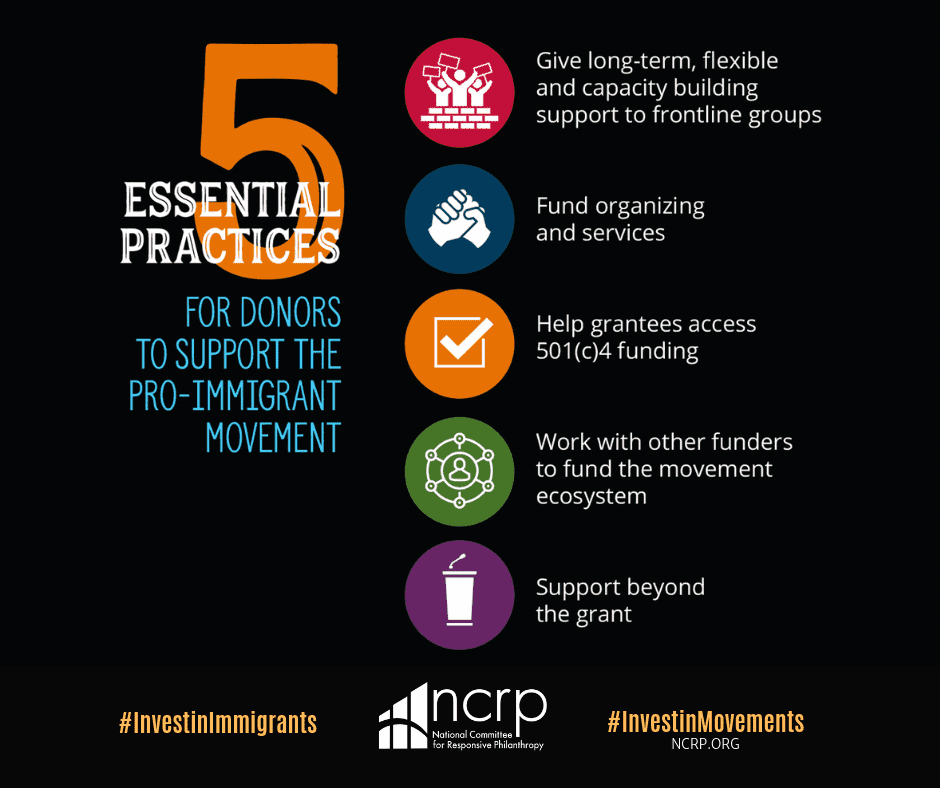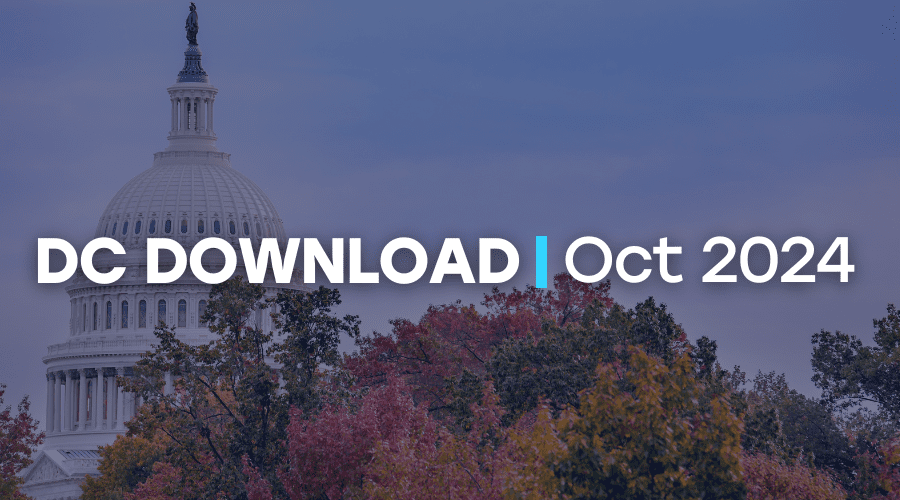The National Committee of Responsive Philanthropy (NCRP) has long been known as an organization that puts listening to the community at the center of its mission. Through this work, they have become one of the most trusted sources on what philanthropy can be doing to serve the most marginalized communities. Their most recent initiative is no different. Organizations, big and small, across the sector, are also realizing that real change often takes support of local, grassroots-led movements rather than top-down strategic plans. It’s through that lens that NCRP released its Movement Investment Project. I recently caught up with Timi Gerson, vice president and chief content officer at NCRP and author of State of Foundation Funding for the Pro-Immigrant Movement, to learn more about their new initiative.
KGC: Tell us about the Movement Investment Project and how it’s different from other initiatives that support movement building.
 TG: This is a historic moment when big questions about the kind of country we want to be are on the table. All of us – grantmakers and grantseekers – want our communities to be safe, healthy, and secure.
TG: This is a historic moment when big questions about the kind of country we want to be are on the table. All of us – grantmakers and grantseekers – want our communities to be safe, healthy, and secure.
Funders have an urgent opportunity to invest in ways that put us on a path toward a more equitable, just, and inclusive future. Social movements are the driving force behind efforts to create this positive change. NCRP’s Movement Investment Project is a multi-year initiative to educate and mobilize the philanthropic sector in support of these movements.
What is a movement? Broadly speaking, a movement is an ecosystem of individuals and groups united by a shared analysis of what is wrong with society and a vision for how it can be changed. These mobilized individuals and organizations collaborate using diverse strategies and tactics, which, when successful, ultimately lead to changes in societal attitudes, practice and policy. From voting rights to marriage equality and beyond, our history demonstrates that movements for social change are what moves us forward as a nation.
NCRP’s unique role is to be a bridge between movements and philanthropy. This project is grounded in the lived experience of the people on the front lines of critical issues as well as deep quantitative data analysis. We are working with movement leaders and innovative funders to educate the philanthropic community about why movements matter and to support grantmakers and donors in how they can be more effective movement givers.
KGC: Why do you want to focus on immigrants?
TG: The Movement Investment Project will focus on different social movements over time. We chose to start with the immigrant and refugee justice movement because of a deep sense of urgency given the political context of deeply inhumane policies such as family separation, and the violent resurgence and mainstreaming of white nationalism, and xenophobic rhetoric and actions across the country.
NCRP believes that immigrant and refugee justice is about all of us, not just those of us who moved here from other countries. Our success is rooted in the success and strength of our communities. Immigrants and refugees are integral members of our communities as mothers, fathers, teachers, students, nurses, doctors, small business owners, farm workers, tech workers, caregivers and more. One in four children in America have at least one immigrant parent.
And yet, grantmakers have not invested in addressing the needs and building the power of our immigrant and refugee communities. For example, from 2011-2015, barely 1% of all money granted by the largest U.S. foundations was intended to benefit these populations.
Additionally, the immigrant and refugee justice movement cuts across many issues. For example:
- It is impossible to talk about educational access and attainment without considering the obstacles facing immigrant students and parents.
- Public health outcomes improve when large swaths of the population aren’t afraid to access health services due to the threat of deportation.
- Gender equity in the workplace is severely undermined when immigrant and refugee women remain vulnerable to unfair pay and abuse on the job.
- Criminal justice reform is incomplete when we don’t recognize and address the negative impact of using local police forces for federal immigration enforcement on the security of our communities.
KGC: Your organization focuses on the grantmakers, but you offer some resources for nonprofit grantseekers too. Tell us a little about that.
TG: We seek to promote high-impact and effective philanthropic practices that are grounded in equity and justice. We believe that we can’t do this without the input and wisdom of nonprofits working on the ground, in the trenches. Grantseekers know what they need to have maximum impact.
One of our goals is to empower nonprofits with the information to confidently and compellingly ask funders for the resources that their organizations need to succeed.
Just as we are helping funders understand the importance of movements, it is useful for grantseekers to understand the donor landscape: What foundations are supporting which movements? Where is the money going geographically and for what kinds of work? We think that this kind of “insider information” will help movement groups advocate for and collaborate around the most effective deployment of philanthropic resources.
For the first phase of the Movement Investment Project, we spoke with hundreds of immigrant and refugee justice organizations at the state, local, and national levels. We paired those conversations with analysis of thousands of grants in this sector over a period of several years. This initiative brings this information and perspective – and as much as possible grassroots leaders themselves – into philanthropic spaces that are often closed to all but the biggest national grantseekers.
KGC: How does this fit into your broader goal of maximizing grantmakers’ impact on equity and justice?
TG: It has been 10 years since NCRP started advocating for a set of aspirational goals for the philanthropic sector rooted in equity and justice embodied in Criteria for Philanthropy at Its Best. What we’ve found is that the rhetoric of the funding world has shifted in the past decade, but the money has not always followed. Funding movements is a way for funders to put their money where their mouths are.
It is also a way for them to be more effective. Building strong movements is the prerequisite to structural change – policy and legal solutions follow movements, not the other way around. The return on investment for movement funding is enormous: Our Leveraging Limited Dollars study found that every dollar grantmakers and other donors invested in core movement strategies such as community organizing, policy advocacy, and civic engagement provided a return of $115 in community benefits that increase equity and justice.
Failure to invest in movements is treating symptoms without addressing the underlying cause – a band-aid approach.
Investing in community-powered grassroots movements works because they alone are capable of shifting systems and re-balancing power in ways that change culture, build political will, and tilt the scales toward more equitable, just policies, practices, and outcomes.
KGC: What can other organizations or individuals do to support this work?
 TG: First and foremost, please share information about the initiative with your colleagues and peer organizations! There is a wealth of materials on our Movement Investment Project website for both funders and grantseekers.
TG: First and foremost, please share information about the initiative with your colleagues and peer organizations! There is a wealth of materials on our Movement Investment Project website for both funders and grantseekers.
For nonprofits, we invite them to use our resources for fundraising. NCRP also has a nonprofit membership program for groups that want to become better informed about the sector and ongoing efforts to engage and educate funders on issues they’re working on. Nonprofits that join become a part of a community working to change the philanthropic sector for the better.
For institutional and individual funders, we hope they will act on the five key recommendations from our first round of research. While some of these are specific to the immigrant and refugee justice movement, many of them are best practices that apply across the board for effective movement support:
- Change how and where you give.
- Integrate movement strategies such as advocacy and organizing.
- Collaborate with other funders to understand and fund the full movement ecosystem.
- Support grantee access to 501(c)4 funds.
- Wield your power to support groups beyond grant dollars.
CRP, Grantmakers Concerned Immigrants and Refugees, and Freedom to Thrive are hosting a webinar for funders on how to divest from immigration detention on June 25. We invite Independent Sector grantmaker members to join us!



